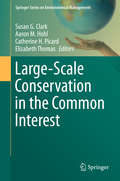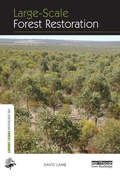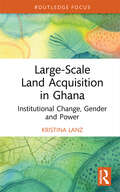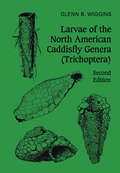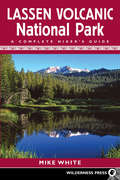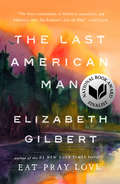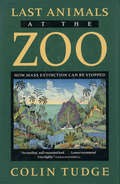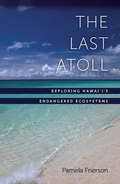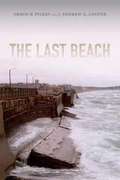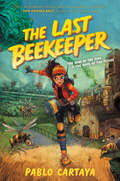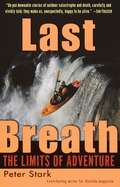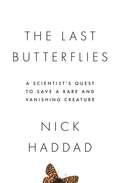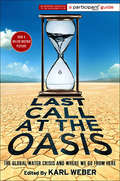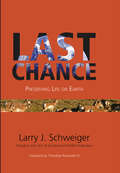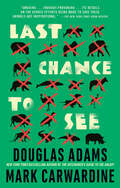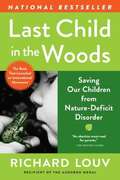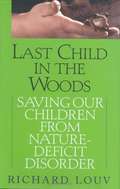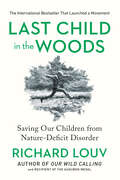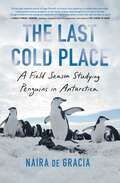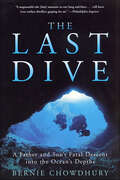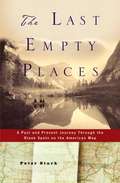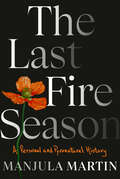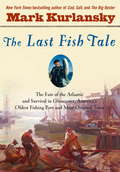- Table View
- List View
Large-Scale Conservation in the Common Interest
by Susan G. Clark Aaron M. Hohl Catherine H. Picard Elizabeth ThomasMany people working toward sustainability recognize the important role of conservation but are inadequately prepared to deal with the large spatial, temporal and complexity scales that are involved in large-scale conservation efforts. Problems in large-scale conservation require navigating an intermixture of geophysical, biological and political dimensions. Coming to grips with these many natural and human forces and factors at large scales, much less the myriad details in any single case, is challenging in the extreme and becomes more critical with each day that passes. Large-scale conservation poses many complex challenges that single disciplines, approaches or methods cannot fully address alone. Interdisciplinarity can significantly strengthen large-scale conservation efforts. Throughout Large-Scale Conservation in the Common Interest the editors and authors argue that a more holistic and genuinely interdisciplinary approach is required to solve the complex and growing challenges associated with large-scale conservation. The chapters within offer such an approach and define key terms, bring challenges to light and employ case studies to offer concrete practical and strategic recommendations to help those who are engaged in the interactive tasks of promoting sustainability and human dignity. This book is intended for a broad audience, including students and professors new to the field of large-scale conservation, experienced field-based practitioners in science and management and decision and policy makers who set specific and strategic direction for large landscapes. Professors can use this book to introduce students to the challenges of successful large-scale conservation design and implementation and to teach interdisciplinarity as a framework, concept and tool. Professionals will find this book offers a new way of using science, management and policy to make decisions. Finally, this volume can be used as a guide to set up workshops, seminars, or projects involving diverse people and perspectives.
Large-scale Forest Restoration (The Earthscan Forest Library)
by David LambLandscapes are being degraded and simplified across the globe. This book explores how forest restoration might be carried out to increase landscape heterogeneity, improve ecological functioning and restore ecosystem services in such landscapes. It focuses on large, landscape-scale reforestation because that is the scale at which restoration is needed if many of the problems that have now developed are to be addressed. It also shows how large-scale forest restoration might improve human livelihoods as well as improve conservation outcomes. A number of governments have undertaken national reforestation programs in recent years; some have been more successful than others. The author reviews these to explore what type of reforestation should be used, where this should be carried out and how much should be done. For example, are the traditional industrial forms of reforestation necessarily the best to use in all situations? How can forest restoration be reconciled with the need for food security? And, are there spatial thresholds that must be exceeded to generate economic and environmental benefits? The book also examines the policy and institutional settings needed to encourage large-scale reforestation. This includes a discussion of the place for incentives to encourage landholders to undertake particular types of reforestation and to reforest particular locations. It also considers forms of governance that are likely to lead to an equitable sharing of the costs and benefits of forest restoration.
Large-Scale Land Acquisition in Ghana: Institutional Change, Gender and Power (Routledge Studies in Global Land and Resource Grabbing)
by Kristina LanzThis book examines a large-scale land acquisition project for rice production in Ghana’s Volta Region, which has been purported by some to be a social and ecological showcase of a company entering a "community–private partnership" with affected communities. Celebrated by national and international media, the project has received substantial amounts of funding from various donor organisations and claims to empower women through its much-lauded outgrower project. Although discourses of "development", "sustainability" and "women’s empowerment" are used by the investment company, the state and the customary authorities to legitimise the large-scale land acquisition, this book highlights how the deal benefits mainly the powerful elite, including elite women, and generally increases the depreciation of those already most marginalised, such as poor female-headed households and settler communities that were dependent on resources from the commons now enclosed and transformed into a rice farm. The author adopts a New Institutionalist perspective in social anthropology in order to analyse how this land acquisition has been implemented in a plural institutional context and how different actors use different rules and regulations and associated legitimating discourses to increase their bargaining power and to pursue their own interests in a changing legal context. In addition, this perspective shows how benefits and losses are distributed along different intersecting axes of power, such as class, gender, clan membership and age. By focusing on power, gender and legitimisation strategies in the context of institutional change caused by the large-scale land acquisition, this book fills a gap in the literature on large-scale land acquisitions while contributing to the development of a theoretical perspective on institutional change, power relations and ideological legitimisation. This book will be of great interest to students and scholars of land and resource grabbing, agricultural development and agribusiness, land management and development studies more broadly.
Larvae of the North American caddisfly genera (trichoptera)
by Glenn B. WigginsCaddisflies are one of the most diverse groups of organisms living in freshwater habitats, and their larvae are involved in energy transfer at several levels within these communities. Caddisfly larvae are also remarkable because of the exquisite food-catching nets and portable cases they construct with silk and selected pieces of plant and rock materials.This book is the most comprehensive existing reference on the aquatic larval stages of the 149 Nearctic genera of Trichoptera, comprising more than 1400 species in North America. The book is invaluable for freshwater biologists and ecologists in identifying caddisfly in the communities they study, for students of aquatic biology as a guide to the diverse fauna of freshwater habitats, and for systematic entomologists as an atlas of the larval morphology of Trichoptera.In the General Section, the biology of caddisfly larvae is considered from an evolutionary point of view. Morphological terms are discussed and illustrated and a classification of the Nearctic genera is given. Techniques are outlined for collecting and preserving larval specimens and for associating larval with adult stages. The Systematic Section begins with a key to larvae of the 26 families of North American Trichoptera. Each chapter in this section is devoted to a particular family, providing a summary of biological features and a key to genera, followed by a two-page outline for each genus with illustrations facing text. This outline provides information on general distribution, number of species, distinctive morphological features, and biological data including construction behaviour.An important feature of the book is the habit illustrations of larvae and cases of a selected species in each genus, along with illustrations of details of significant morphological structures. Each generic type is thus presented as a recognizable whole organism adapted in elegant ways to particular niches of freshwater communities.This revised edition includes advances in knowledge on the classification and biology of Trichoptera up to 1993 - an interval of 17 years since the first edition. An additional eight families and thirteen genera are included for the first time. Through reorganization of the families into three suborders, a biological context has been established for the systematic section.
Lassen Volcanic National Park
by Mike WhiteThe guide to the hikers' paradise of Lassen Volcanic National Park - with its still-active geologic wonders and view-packed summits - has been completely updated and expanded, with new trips, photos, and maps to complement the user-friendly design of the popular National Park series. Revamped by veteran author Mike White, this guide features 95 dayhike and backpack trips to popular sites such as Lassen Peak and Bumpass Hell, as well as little-known backcountry gems. Also included are trips into regions surrounding the Park, including the Hat Creek Recreation Area, greater Susanville-Chester area, Warner Valley, Butte Lake, and Drakesbad regions, McArthur-Burney Falls Memorial State Park, plus the Thousand Lakes, Caribou, Ishi, and Bucks Lake wilderness areas.
The Last American Man
by Elizabeth Gilbert<P>In this rousing examination of contemporary American male identity, acclaimed author and journalist Elizabeth Gilbert explores the fascinating true story of Eustace Conway. <P>In 1977, at the age of seventeen, Conway left his family's comfortable suburban home to move to the Appalachian Mountains. <P>For more than two decades he has lived there, making fire with sticks, wearing skins from animals he has trapped, and trying to convince Americans to give up their materialistic lifestyles and return with him back to nature. <P>To Gilbert, Conway's mythical character challenges all our assumptions about what it is to be a modern man in America; he is a symbol of much we feel how our men should be, but rarely are. <P><b>Finalist for the National Book Award 2002</b>
Last Animals at the Zoo: How Mass Extinction Can Be Stopped
by Colin TudgeIn Last Animals at the Zoo, Colin Tudge argues that zoos have become an essential part of modern conservation strategy, and that the only real hope for saving many endangered species is through creative use of zoos in combination with restoration of natural habitats. From the genetics of captive breeding to techniques of behavioral enrichment, Tudge examines all aspects of zoo conservation programs and explains how the precarious existence of so many animals can best be protected.
The Last Atoll
by Pamela FriersonThe Last Atoll is a first-person account of journalist Pamela Frierson's ten-year exploration of the exotic and ecologically significant small lands at the far northwestern end of the Hawaiian island chain. Frierson takes readers on a rare journey to eight of these remote and ancient islands, including the Kure Atoll, the oldest Hawa'i'ian island and the northernmost atoll in the world. In her 1,200-mile travels, Frierson discovers isolated landscapes, undisturbed ecosystems, and a nearly forgotten but well-preserved human history. It is a rich history of discovery by explorers and pirates, plus extensive military use. Frierson finds a vast wilderness, including the remnants of ancient volcanoes, and unique species of wildlife. She also explores the islands' location in the Great Pacific Garbage Patch, a major current that washes up the world's garbage. A lifelong resident of Hawai'i, Frierson draws broad conclusions relating to islands and their "canary in a coal mine" role.
The Last Atoll
by Pamela FriersonThe Last Atoll is a first-person account of journalist Pamela Frierson's ten-year exploration of the exotic and ecologically significant small lands at the far northwestern end of the Hawaiian island chain. Frierson takes readers on a rare journey to eight of these remote and ancient islands, including the Kure Atoll, the oldest Hawa'i'ian island and the northernmost atoll in the world. In her 1,200-mile travels, Frierson discovers isolated landscapes, undisturbed ecosystems, and a nearly forgotten but well-preserved human history. It is a rich history of discovery by explorers and pirates, plus extensive military use. Frierson finds a vast wilderness, including the remnants of ancient volcanoes, and unique species of wildlife. She also explores the islands' location in the Great Pacific Garbage Patch, a major current that washes up the world's garbage. A lifelong resident of Hawai'i, Frierson draws broad conclusions relating to islands and their "canary in a coal mine" role.
The Last Beach
by Orrin H. Pilkey Jr. J. Andrew CooperThe Last Beach is an urgent call to save the world's beaches while there is still time. The geologists Orrin H. Pilkey and J. Andrew G. Cooper sound the alarm in this frank assessment of our current relationship with beaches and their grim future if we do not change the way we understand and treat our irreplaceable shores. Combining case studies and anecdotes from around the world, they argue that many of the world's developed beaches, including some in Florida and in Spain, are virtually doomed and that we must act immediately to save imperiled beaches.After explaining beaches as dynamic ecosystems, Pilkey and Cooper assess the harm done by dense oceanfront development accompanied by the construction of massive seawalls to protect new buildings from a shoreline that encroaches as sea levels rise. They discuss the toll taken by sand mining, trash that washes up on beaches, and pollution, which has contaminated not only the water but also, surprisingly, the sand. Acknowledging the challenge of reconciling our actions with our love of beaches, the geologists offer suggestions for reversing course, insisting that given the space, beaches can take care of themselves and provide us with multiple benefits.
The Last Beekeeper
by Pablo CartayaFacing a world dually altered by climate change and those who profit from it, Yolanda Cicerón will have to fight to save the last known beehive from extinction in this stirring new adventure by award-winning author Pablo Cartaya.In a future shaken by climate disasters, Yolanda Cicerón knows that nature is something to be feared. While life in the Valley is brutal and harsh, Yoly dreams of leaving her farm to live in Silo—the most advanced town for miles around. But first, Yoly will need to prove she belongs in a place where only the smartest and most useful are welcomed. Between her razor-sharp smarts and sheer determination, Yoly is well on her way until she discovers her family can no longer afford her schooling. When forced to take matters into her own hands, the closer she gets to securing her future, the more she uncovers the dangers lying inside Silo’s walls—ones that threaten the entire Valley. As she cracks long-guarded secrets, Yoly, along with those closest to her, is put in grave peril and the only chance of surviving may lie in the rediscovery of a long-extinct species—the honeybee. Can the last surviving beehive be the key to pulling the Valley out from under Silo’s thumb, or will they destroy what remains of Yoly’s future?
Last Breath
by Peter Stark"Forget the edge of your seat. Last Breathtakes you to the edge of your life, for a pulse-pounding glimpse into the Great Beyond. There are many ways to risk your life in the out-of-doors, and Stark has captured them in exquisite and harrowing detail. " -JIM ROBBINS Author ofA Symphony in the Brain An enthralling blend of adventure and science, Last Breath re-creates in heart-stopping detail what happens to our bodies and our minds in the perilous last moments of life when an extreme adventure goes awry. Combining the adrenaline high of extreme sports with the startling facts of physiological reality, veteran travel and outdoor sports writer Peter Stark narrates a series of adventure stories in which thrill can cross the line to mortal peril. Each death or brush with death is at once a suspense story, a cautionary tale, and a medical thriller. Will they survive, or will they succumb? Readers will shiver with a man lost in the snowy woods, suffering from hypothermia and tearsing off his clothes as he's burning up from the cold; they will hallucinate with a young woman stranded at the top of Annapurna as she experiences a cerebral edema; and while a kayaker tumbles helplessly underwater for two minutes, five minutes, ten minutes, readers, too, will gasp for their last breath.
The Last Butterflies: A Scientist's Quest to Save a Rare and Vanishing Creature
by Nick HaddadA remarkable look at the rarest butterflies, how global changes threaten their existence, and how we can bring them back from near-extinctionMost of us have heard of such popular butterflies as the Monarch or Painted Lady. But what about the Fender’s Blue? Or the St. Francis’ Satyr? Because of their extreme rarity, these butterflies are not well-known, yet they are remarkable species with important lessons to teach us. The Last Butterflies spotlights the rarest of these creatures—some numbering no more than what can be held in one hand. Drawing from his own first-hand experiences, Nick Haddad explores the challenges of tracking these vanishing butterflies, why they are disappearing, and why they are worth saving. He also provides startling insights into the effects of human activity and environmental change on the planet’s biodiversity.Weaving a vivid and personal narrative with ideas from ecology and conservation, Haddad illustrates the race against time to reverse the decline of six butterfly species. Many scientists mistakenly assume we fully understand butterflies’ natural histories. Yet, as with the Large Blue in England, we too often know too little and the conservation consequences are dire. Haddad argues that a hands-off approach is not effective and that in many instances, like for the Fender’s Blue and Bay Checkerspot, active and aggressive management is necessary. With deliberate conservation, rare butterflies can coexist with people, inhabit urban fringes, and, in the case of the St. Francis’ Satyr, even reside on bomb ranges and military land. Haddad shows that through the efforts to protect and restore butterflies, we might learn how to successfully confront conservation issues for all animals and plants.A moving account of extinction, recovery, and hope, The Last Butterflies demonstrates the great value of these beautiful insects to science, conservation, and people.
Last Call at the Oasis: The Global Water Crisis and Where We Go from Here
by Participant Media"If there was a price placed on clean water we might start treating it like it has value. Maybe when it's gone we'll realize we can't drink oil or money. " --Dave Matthews Less than 1 percent of the world's water is fresh and potable--and no more will ever be available. Thanks to pollution, global warming, and population growth, water access is poised to become today's most explosive global issue. This book, based on the film Last Call at the Oasis by Academy Award®-winning director Jessica Yu, offers insights into the coming water crisis from visionary scientists, policymakers, activists, and environmentalists, including: ROBERT MORAN on how oil and mineral development pollute and divert water supplies--often beyond public scrutiny PETER H. GLEICK on discovering the "soft path" to global water security ROBERT GLENNON on how the power of markets can help protect the world's water LYNN HENNING on how a family farmer became a passionate "water activist" ALEX PRUD'HOMME on how the water crisis affects us all GARY WHITE on how innovative social and economic strategies can make clean water available even for the world's poorest people HADLEY ARNOLD AND PETER ARNOLD on how arid regions like America's Southwest can wisely husband water supplies for cities and farmers alike ROBYN BEAVERS on how today's smartest businesses are making sustainable water management a competitive advantage ZEM JOAQUIN on nine "ecofabulous" ways of saving water at home--and doing it with style BILL MCDONOUGH on how smart design can preserve water's "Endless Resourcefulness" for generations to come No resource on earth is more precious--or more endangered--than water. Last Call at the Oasis is a powerful tool for learning about the water challenges we face as well as the remarkable solutions available to us--if we have the will to use them.
Last Chance: Preserving Life in Earth (Speaker's Corner Ser.)
by Larry J Schweiger"This is an unabashed call to each and every American to moral duty for the future of life on earth," begins National Wildlife Federation president and CEO Larry J. Schweiger in this stirring exposé and call to action. Speaking to us not just as a conservation leader but also as an outdoor lover and a parent, Schweiger describes the causes and effects of global warming on our wildlife, ecosystems, and human life as we know it. With an engaging, down-to-earth tone (and a dash of wit; e.g., "What Happens in Greenland Will Not Stay in Greenland"), Schweiger breaks down the science behind our looming environmental catastrophe. Not letting go of hope, he also offers practical solutions and proposes a plan of action for everyday citizens. Last Chance will inspire each of us to take part in restoring the vital connection to our natural world before it's too late."
Last Chance to See
by Douglas Adams Mark Carwardine"Very funny and moving...The glimpses of rare fauna seem to have enlarged [Adams'] thinking, enlivened his world; and so might the animals do for us all, if we were to help them live."THE WASHINGTON POST BOOK WORLDJoin bestselling author Douglas Adams and zooligist Mark Carwardine as they take off around the world in search of exotic, endangered creatures. Hilarious and poignant--as only Douglas Adams can be--LAST CHANCE TO SEE is an entertaining and arresting odyssey through the Earth's magnificent wildlife galaxy.From the Trade Paperback edition.
Last Child in the Woods: Saving Our Children from Nature-Deficit Disorder
by Richard Louv"The children and nature movement is fueled by this fundamental idea: the child in nature is an endangered species, and the health of children and the health of the Earth are inseparable. " --Richard Louv, from the new edition In his landmark work Last Child in the Woods, Richard Louv brought together cutting-edge studies that pointed to direct exposure to nature as essential for a child's healthy physical and emotional development. Now this new edition updates the growing body of evidence linking the lack of nature in children's lives and the rise in obesity, attention disorders, and depression. Louv's message has galvanized an international back-to-nature campaign to "Leave No Child Inside. " His book will change the way you think about our future and the future of our children. "[The] national movement to 'leave no child inside' . . . has been the focus of Capitol Hill hearings, state legislative action, grass-roots projects, a U. S. Forest Service initiative to get more children into the woods and a national effort to promote a 'green hour' in each day. . . . The increased activism has been partly inspired by a best-selling book, Last Child in the Woods, and its author, Richard Louv. " --The Washington Post "Last Child in the Woods, which describes a generation so plugged into electronic diversions that it has lost its connection to the natural world, is helping drive a movement quickly flourishing across the nation. " --The Nation's Health "This book is an absolute must-read for parents. " --The Boston Globe Now includes A Field Guide with 100 Practical Actions We Can Take Discussion Points for Book Groups, Classrooms, and Communities Additional Notes by the Author New and Updated Research from the U. S. and Abroad
Last Child in the Woods: Saving Our Children from Nature-Deficit Disorder
by Richard LouvFrom the Book Jacket: "I like to play indoors better 'cause that's where all the electrical outlets are," reports a fourth-grader. Never before in history have children been so plugged-in-and so out of touch with the natural world. In this groundbreaking new work, child advocacy expert Richard Louv direcdy links the lack of nature in the lives of today's wired generation-he calls it nature deficit-to some of the most disturbing childhood trends, such as rises in obesity, Attention Deficit Disorder (ADD), and depression. Some startling facts: By the 1990s the radius around the home where children were allowed to roam on their own had shrunk to a ninth of what it had been in 1970. Today, average eight-year- olds are better able to identify cartoon characters than native species, such as beetles and oak trees, in their own community. The rate at which doctors prescribe antidepressants to children has doubled in the last five years, and recent studies show that too much computer use spells trouble for the developing mind. Nature-deficit disorder is not a medical condition; it is a description of the human costs of alienation from nature. This alienation damages children and shapes adults, families, and communities. There are solutions, though, and they're right in our own backyards. Last Child in the Woods is the first book to bring together cutting-edge research showing that direct exposure to nature is essential for healthy childhood development-physical, emotional, and spiritual. What's more, nature is a potent therapy for depression, obesity, and ADD. Environment-based education dramatically improves standardized test scores and grade point averages and develops skills in problem solving, critical thinking, and decision making. Even creativity is stimulated by childhood experiences in nature. Yet sending kids outside to play is increasingly difficult. Computers, television, and video games compete for their time, of course, but it's also our fears of traffic, strangers, even virus- carrying mosquitoes-fears the media exploit- that keep children indoors. Meanwhile, schools assign more and more homework, and there is less and less access to natural areas. Parents have the power to ensure that their daughter or son will not be the "last child in the woods," and this book is the first step toward that nature-child reunion.
Last Child in the Woods: Saving Our Children From Nature-Deficit Disorder
by Richard Louv“The children and nature movement is fueled by this fundamental idea: the child in nature is an endangered species, and the health of children and the health of the Earth are inseparable.” —Richard Louv, from the new edition In his landmark work Last Child in the Woods, Richard Louv brought together cutting-edge studies that pointed to direct exposure to nature as essential for a child’s healthy physical and emotional development. Now this new edition updates the growing body of evidence linking the lack of nature in children’s lives and the rise in obesity, attention disorders, and depression. Louv’s message has galvanized an international back-to-nature campaign to “Leave No Child Inside.” His book will change the way you think about our future and the future of our children. “[The] national movement to ‘leave no child inside’ . . . has been the focus of Capitol Hill hearings, state legislative action, grass-roots projects, a U.S. Forest Service initiative to get more children into the woods and a national effort to promote a ‘green hour’ in each day. . . . The increased activism has been partly inspired by a best-selling book, Last Child in the Woods, and its author, Richard Louv.” —The Washington Post “Last Child in the Woods, which describes a generation so plugged into electronic diversions that it has lost its connection to the natural world, is helping drive a movement quickly flourishing across the nation.” —The Nation’s Health “This book is an absolute must-read for parents.” —The Boston Globe Now includesA Field Guide with 100 Practical Actions We Can Take Discussion Points for Book Groups, Classrooms, and Communities Additional Notes by the Author New and Updated Research from the U.S. and Abroad
The Last Cold Place: A Field Season Studying Penguins in Antarctica
by Naira de GraciaLab Girl meets Why Fish Don&’t Exist in this brilliant, fascinating memoir about a young scientist&’s experience studying penguins in Antarctica—a firsthand account of the beauty and brutality of this remote climate, the direct effects of climate change on animals, and the challenges of fieldwork.Naira de Gracia&’s The Last Cold Place offers a dramatic, captivating window into a once-in-a-lifetime experience: a season living and working in a remote outpost in Antarctica alongside seals, penguins, and a small crew of fellow field workers. In one of the most inhospitable environments in the world (for humans, anyway), Naira follows a generation of chinstrap penguins from their parents&’ return to shore to build nests from pebbles until the chicks themselves are old enough to head out to sea. In lively and entertaining anecdotes, Naira describes the life cycle of a funny, engaging colony of chinstrap penguins whose food source (krill, or small crustaceans) is powerfully affected by the changing ocean. Weaving together the history of Antarctic exploration with climate science, field observations, and her own personal journey of growth and reflection, The Last Cold Place illuminates the complex place that Antarctica holds in our cultural imagination—and offers a rare glimpse into life on this uninhabited continent.
The Last Dive: A Father and Son's Fatal Descent into the Ocean's Depths
by Bernie Chowdhury“Superbly written and action-packed, The Last Dive ranks with such adventure classics as The Perfect Storm and Into Thin Air.”—Tampa TribuneSpurred on by a fatal combination of obsession and ambition, Chris and Chrisy Rouse, an experienced father-son scuba diving team, hoped to achieve wide-spread recognition for their outstanding and controversial diving skills by solving the secrets of a mysterious, undocumented, World War II German U-boat that lay only a half day’s mission from New York Harbor.The Rouses found the ultimate cost of chasing their personal challenge: death from what divers dread the most—decompression sickness, or “the bends.” In this gripping recounting of their tragedy, author Bernie Chowdhury, himself an expert diver, explores the thrill-seeking, high-risk world of deep sea diving, its legendary figures, most celebrated triumphs, and notorious tragedies.
The Last Eagle
by Daniel MannixSurvival--against the hostility of man and beast, and against the dreadful odds of Nature--is the theme of this magnificent book, a beautifully written fictionalised biography. It tells the story, from timorous infancy to glorious maturity, of an American bald eagle. Daniel Mannix captures all the poetry, romance, and glory of an eagle's life, while telling his reader how it must feel to be a fledgling struggling for food, a young bird just learning to hunt, and finally what it must be like to reign as acknowledged lord of the skies. The eagle of which the author writes may well be the last; the bald eagles have been badly depleted by hunters, vandals, and egg collectors. THE LAST EAGLE is both a poignant and fascinating story and a plea for conservation.
The Last Empty Places: A Past and Present Journey through the Blank Spots on the American Map
by Peter StarkFor readers of both travel and history, Stark explores the blank spots on the U. S. map, weaving together riveting American history, a wonderful contemporary travelogue, and a deeply engaging examination of the history of wilderness.
The Last Fire Season: A Personal and Pyronatural History
by Manjula MartinH Is for Hawk meets Joan Didion in the Pyrocene in this arresting combination of memoir, natural history, and literary inquiry that chronicles one woman&’s experience of life in Northern California during the worst fire season on record.A MOST-ANTICIPATED BOOK: The New York Times, The Los Angeles Times, The San Francisco Chronicle, The Saturday Evening Post, Poets & Writers, The Millions, Alta, Heat Map NewsTold in luminous, perceptive prose, The Last Fire Season is a deeply incisive inquiry into what it really means—now—to live in relationship to the elements of the natural world. When Manjula Martin moved from the city to the woods of Northern California, she wanted to be closer to the wilderness that she had loved as a child. She was also seeking refuge from a health crisis that left her with chronic pain, and found a sense of healing through tending her garden beneath the redwoods of Sonoma County. But the landscape that Martin treasured was an ecosystem already in crisis. Wildfires fueled by climate change were growing bigger and more frequent: each autumn, her garden filled with smoke and ash, and the local firehouse siren wailed deep into the night.In 2020, when a dry lightning storm ignited hundreds of simultaneous wildfires across the West and kicked off the worst fire season on record, Martin, along with thousands of other Californians, evacuated her home in the midst of a pandemic. Both a love letter to the forests of the West and an interrogation of the colonialist practices that led to their current dilemma, The Last Fire Season, follows her from the oaky hills of Sonoma County to the redwood forests of coastal Santa Cruz, to the pines and peaks of the Sierra Nevada, as she seeks shelter, bears witness to the devastation, and tries to better understand fire&’s role in the ecology of the West. As Martin seeks a way to navigate the daily experience of living in a damaged body on a damaged planet, she comes to question her own assumptions about nature and the complicated connections between people and the land on which we live.
The Last Fish Tale: The Fate of the Atlantic and Our Disappearing Fisheries
by Mark KurlanskyWill most of the major fisheries of the world be exhausted by 2048, as has been claimed? Have the number of large fish in the ocean decreased by 90 per cent over the past 50 years, as has been asserted by a respected scientist? Are 60 per cent of the fish species studied by the United Nations Food and Agriculture Organisation either fully exploited or depleted, as one of their reports attests? Fishing at sea, an ancient trade and a way of life that has defined coastal towns throughout history, may be coming to an end. The culture and traditions of coastal Britain and of seagoing nations everywhere are now threatened with extinction. In his most important book yet, Mark Kurlansky - the celebrated author of Cod, Salt and The Big Oyster - explores the fate of our oceans and the decline of our most ancient coastal enterprise. The Last Fish Tale sends up a timely distress flare but one which brilliantly illuminates a colourful, exuberant and poignant landscape, from Newlyn in Cornwall to Gloucester in Massachusetts - a fishing village first settled by Englishmen in the early 1600s. The result is a cultural, economic, environmental and culinary bouillabaisse - the most compelling fish tale of our time.
